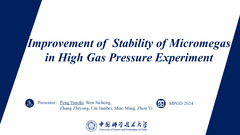Study on the long-term stability of thermal bonding Micromegas detectors for high gas pressure experiments
ID:57
Submission ID:58 View Protection:ATTENDEE
Updated Time:2024-09-02 15:55:17
Hits:574
Oral Presentation
Abstract
Micro-pattern gas detectors (MPGDs) are widely used to measure particle momentum and trajectory in high-energy physics research. Operating at high pressures has expanded their ability to measure the energy spectrum of electrons and gamma rays at the MeV energy level, and have considerable prospects in the next generation of rare event searches and space astronomy experiments. For example, the NEXT and PandaX-III experiments are committed to searching for neutrino-less double beta decay events of 136Xe at pressures of 10 bar and above, and experiments such as HARPO, SMILES-2+, AdEPT, and MeGaT are designed to detect MeV gamma rays in the balloon-based or satellite-based scenarios. However, to date, how to ensure the long-term stable and high-performance operation of MPGD detectors under high-pressure conditions remains a big challenge.
Over the past few years, we've researched high-stability, high-performance Micromegas detectors using thermal bonding for the PandaX-III experiment under 10 bar xenon conditions. We developed a low-background, high-resolution detector and conducted tests under high-pressure conditions. However, the detector with thermal bonding film spacers still faces challenges in achieving long-term stability under high-pressure xenon conditions. To this end, we continue to study methods to achieve high-pressure stability of detectors, starting from the materials and manufacturing processes. We will review the relevant research experience, demonstrate the performance of the detector, and focus on analyzing the key factors that affect the stability.
Keywords
Micromegas,stability,high gas pressure




Comment submit